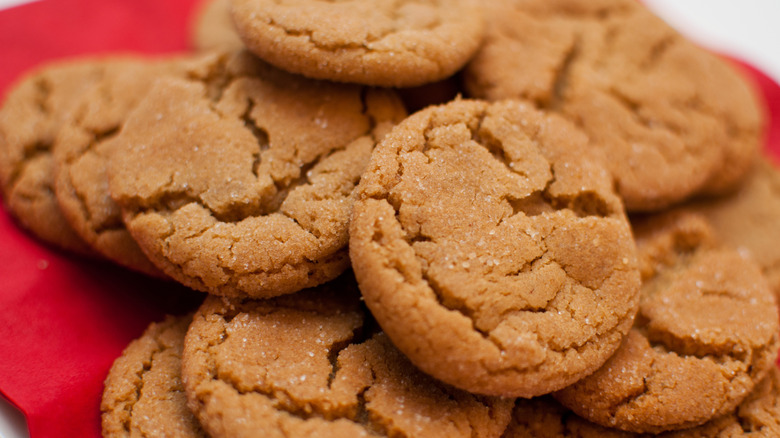The Exact Difference Between Gingerbread And Ginger Snaps
While both are warming, gently spiced, and often associated with winter festivities and the holiday season, you shouldn't use the terms gingerbread and ginger snap interchangeably — it turns out, there's a bit more to how the cookies crumble. The two are quite different, both in terms of ingredients, preparation, history, and the finished product. For the avid home baker or anyone who appreciates the subtle nuances of culinary history, it's worth knowing what makes each cookie unique.
Both sweet and spicy treats have storied pasts and were popular in at least early colonial American history, if not much, much further back, but have long been rather distinct treats in their own rights. When you hear gingerbread cookies, you probably think of the person-shaped gingerbread men or other festive holiday shapes, whereas ginger snaps tend to be baked into small circles. That's one noteworthy difference, along with their various ingredients and preparation.
By technical definition, ginger snaps are sweetened with molasses versus sugar, though you'll certainly find modern recipes using both. And if rolled out and cut into a shape — like a person, star, or walls and a roof for building a gingerbread house — that's a gingerbread cookie, not a ginger snap. When it comes down to texture, ginger snaps, which tend to cook longer in the oven, are more brittle and snappy (hence the name), compared to the softer, more cakey texture of a true gingerbread cookie.
Both sweet and spicy treats date back centuries
Some form of gingerbread cookie or ginger snap — or their cousin, the ever-popular snickerdoodle — is a common appearance on holiday cookie trays, at decorating parties, and in bakery cases year round. Their staying power is impressive, considering people have been enjoying gingery baked treats since ancient times. Gingerbread itself dates back even further, present in ancient Egyptian, Greek, and medieval English cooking where it was used for a variety of purposes from ceremonial to aiding in digestion after meals.
These very early iterations were rustic, simple concoctions made with honey and dry goods. It was in medieval times when the first gingerbread cookies took shape — pun intended. As we know and still decorate them today, gingerbread men came into popularity during Shakespeare's time, when dough was rolled out and cut into shapes from biblical figures to royal dignitaries.
Ginger snaps, on the other hand, evolved into the version we know now back in Revolutionary War-era America, though they were brought to the country by European colonial settlers. Mentioned in American cookbooks in the early 1800s, these crispier cookies were traditionally made with molasses and no egg. Though they certainly evolved from the same roots of gingerbread cookies, which were produced centuries earlier, these plainer, usually undecorated cookies remain the perfect small treat for enjoying with a cup of tea today.

